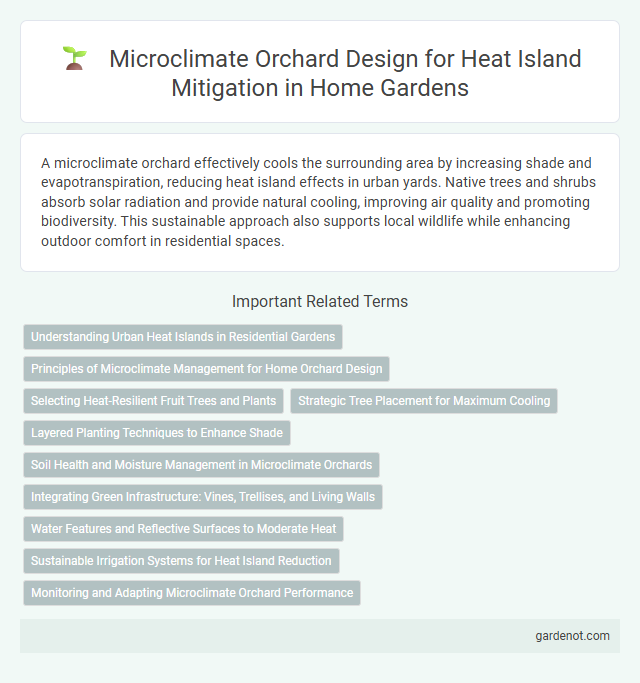A microclimate orchard effectively cools the surrounding area by increasing shade and evapotranspiration, reducing heat island effects in urban yards. Native trees and shrubs absorb solar radiation and provide natural cooling, improving air quality and promoting biodiversity. This sustainable approach also supports local wildlife while enhancing outdoor comfort in residential spaces.
Understanding Urban Heat Islands in Residential Gardens
Microclimate orchards in residential gardens play a crucial role in mitigating urban heat islands by enhancing localized cooling through evapotranspiration and shading. Strategically planting diverse tree species with high canopy density reduces surface temperatures and improves air quality within urban neighborhoods. Implementing these green spaces increases biodiversity while creating comfortable microclimates that counteract the heat retention of impervious surfaces.
Principles of Microclimate Management for Home Orchard Design
Microclimate orchard design for heat island mitigation prioritizes key principles such as optimizing canopy cover to provide shade and reduce ambient temperatures. Strategic placement of drought-tolerant and native species enhances air circulation and soil moisture retention, improving overall orchard resilience. Incorporating reflective mulches and windbreaks further moderates temperature extremes, creating a stable, cooler microenvironment within the home orchard.
Selecting Heat-Resilient Fruit Trees and Plants
Selecting heat-resilient fruit trees and plants is crucial for effective microclimate orchard management in heat island mitigation yards. Species such as pomegranate, fig, and olive trees exhibit high tolerance to elevated temperatures and drought conditions, enhancing orchard sustainability. Incorporating native, drought-resistant understory plants further improves soil moisture retention and reduces ambient heat within the orchard microclimate.
Strategic Tree Placement for Maximum Cooling
Strategic tree placement in a microclimate orchard significantly enhances heat island mitigation by maximizing shade and evapotranspiration cooling effects. Positioning trees to block solar radiation during peak heat hours reduces ambient temperatures and lowers surrounding surface heat. Incorporating diverse species with varying canopy densities optimizes airflow and humidity regulation, creating a cooler, more comfortable microclimate in urban yards.
Layered Planting Techniques to Enhance Shade
Layered planting techniques in microclimate orchards create multiple canopy levels that significantly increase shade coverage, reducing ground surface temperatures and mitigating heat island effects. By strategically placing trees, shrubs, and groundcover plants in vertical and horizontal layers, these systems enhance evapotranspiration and airflow, improving overall cooling efficiency. This approach not only provides thermal comfort but also supports biodiversity and soil health in urban heat island mitigation yards.
Soil Health and Moisture Management in Microclimate Orchards
Microclimate orchards improve soil health by enhancing organic matter through mulching and composting, which promotes beneficial microbial activity and nutrient cycling. Effective moisture management involves implementing drip irrigation and rainwater harvesting systems to maintain consistent soil moisture levels, reducing evaporation and water stress. These practices collectively support healthier root systems and increase resilience against heat island effects.
Integrating Green Infrastructure: Vines, Trellises, and Living Walls
Integrating green infrastructure such as vines, trellises, and living walls in a microclimate orchard enhances heat island mitigation by increasing shade and evapotranspiration, which lower local temperatures effectively. These structures support diverse plant growth that improves air quality and reduces surface heat absorption through natural insulation. Employing such green designs promotes sustainable urban cooling and fosters biodiversity within heat-sensitive environments.
Water Features and Reflective Surfaces to Moderate Heat
Water features in a microclimate orchard enhance evaporative cooling, lowering ambient temperatures and increasing humidity to mitigate urban heat island effects. Reflective surfaces, such as light-colored pavements and reflective mulches, reduce heat absorption by reflecting solar radiation, thereby decreasing ground temperatures. Integrating these elements optimizes thermal comfort and supports sustainable orchard microclimate management.
Sustainable Irrigation Systems for Heat Island Reduction
Sustainable irrigation systems in microclimate orchards optimize water use efficiency, reducing soil evaporation and promoting cooler ambient temperatures that mitigate urban heat island effects. Drip irrigation and subsurface watering techniques maintain consistent soil moisture, supporting healthy tree canopies that provide natural shading and evapotranspiration cooling. Integrating sensor-driven, automated irrigation further conserves water resources while enhancing microclimate regulation and heat island reduction.
Monitoring and Adapting Microclimate Orchard Performance
Monitoring microclimate orchard performance involves using sensors to track temperature, humidity, and soil moisture, providing real-time data crucial for heat island mitigation. Adaptive strategies include adjusting irrigation schedules and plant species selection based on microclimate feedback to optimize cooling effects. Continuous data analysis helps enhance canopy cover and evapotranspiration rates, contributing to effective urban heat reduction.
Microclimate orchard Infographic

 gardenot.com
gardenot.com